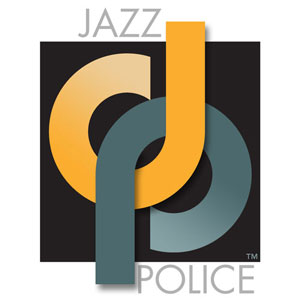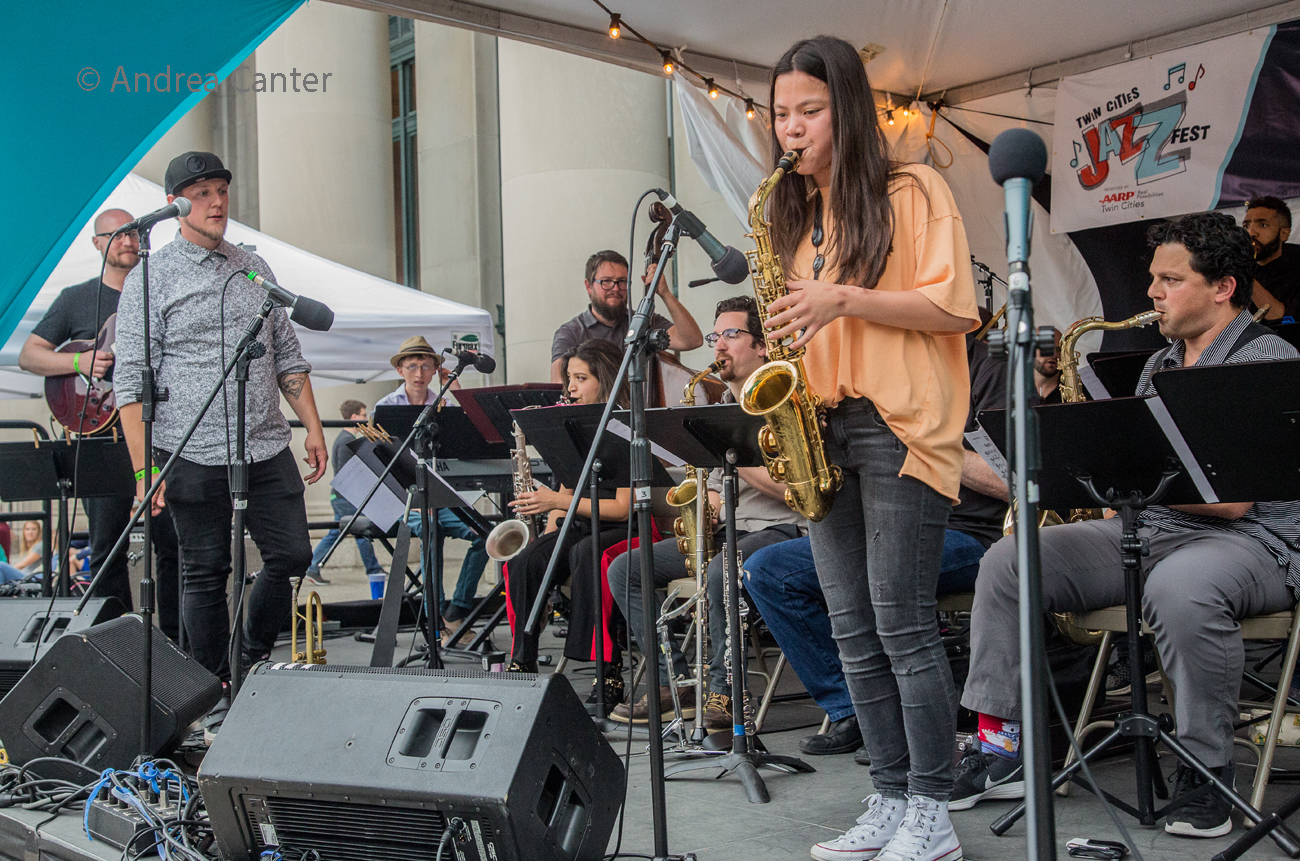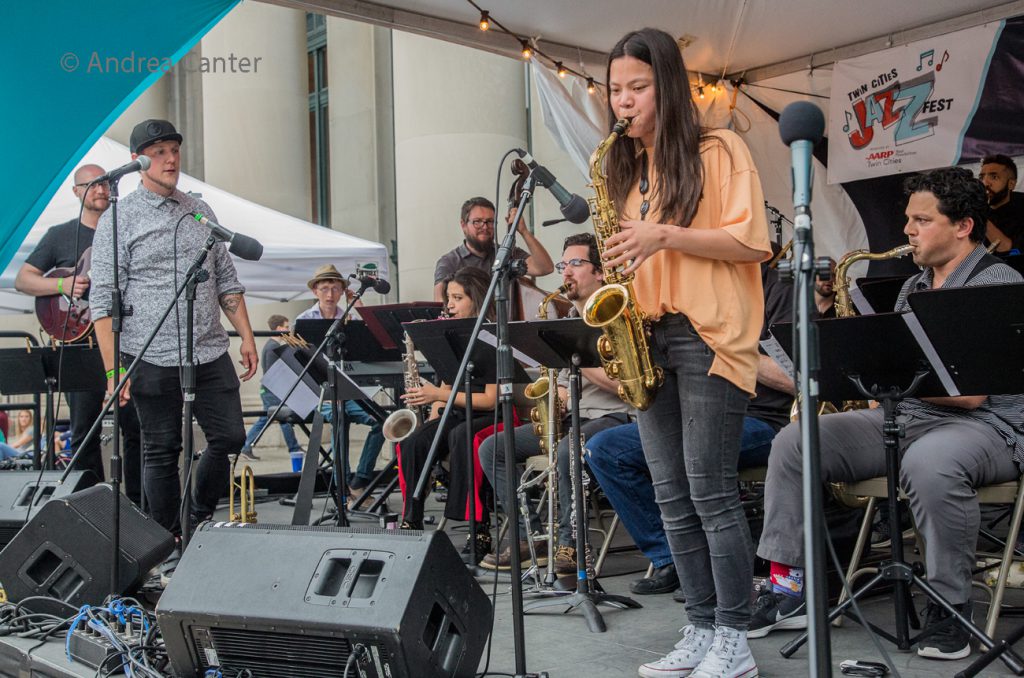
Since the first Dakota Combo was launched in 2006 as an audition-only ensemble of high school jazz students, I’ve had the pleasure to meet and observe some very talented young musicians. Originally a collaboration of the Dakota Foundation for Jazz Education and MacPhail Center for Music, the Dakota Combo, each year, brought together students from all corners of the metro and beyond, each already serious about his or her instrument and jazz music and eager to enhance skills in improvisation and group interplay under the direction of Kelly Rossum (through 2009) and then Adam Linz (through 2019). Over the past thirteen years, I have also witnessed the launching of numerous careers in music, primarily jazz, most within the Twin Cities Area. Sometimes it seemed easy to predict which students would go on to success in college jazz programs and beyond. And indeed, the local jazz scene today is dotted with Dakota Combo alums (as well as alums of other ensembles like Minnesota Youth Jazz Band (MYJB), All-State Jazz Band)–trumpeter Jake Baldwin, saxophonists Stephanie Wieseler, Thomas Strommen and Peter Goggin, trombonist Ben Link, vibraphonist Levi Schwartzberg, drummer Ben Ehrlich, bassists Sam Worthington and Charlie Lincoln, guitarist Geoff LeCrone, and pianist Joe Strachan (as well as Javi Santiago and Will Kjeer, who we might count as part-time residents).
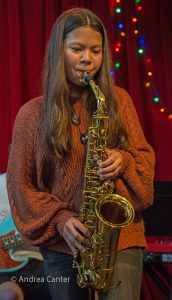
But perhaps none has been as impressive at an early stage of her career as alto saxophonist Sophia Kickhofel, entering her junior year at Apple Valley High School after a summer stint with the National Youth Jazz Orchestra. Sponsored by Carnegie Hall, the NYO-Jazz selects 23 students nationwide (juniors and seniors) to participate in two weeks of rehearsal, a concert at Carnegie Hall, and another two weeks touring Taiwan and mainland China. Barely home a week, Sophia was invited to perform at the 100th birthday celebration for Irv Williams at The Dakota, where she learned she was the first recipient of the new Irv Williams Scholarship, awarded by Dakota co-owner Lowell Pickett. This fall, she will again audition for the Dakota Combo and participate in MYJB, her school jazz ensembles, and a rather long list of local jazz gigs, only some of which are student-led.
How does a program like the NYJO impact a budding professional like Sophia? Just before the start of a new school year, I asked her–about NYJO specifically and more generally about her commitment to jazz and the saxophone.
Discovering Sax and Jazz
The saxophone was Sophia’s first instrument, although not her first choice. “I started playing [saxophone] the summer going into 5th grade, so I think I was nine or ten… I didn’t even know what a saxophone was. I remember I really wanted to play trumpet, and my mom didn’t let me. It was too spitty. There’s a spit valve. It’s gross.” So, Sophia started out on alto and “I just never switched. I played bari in middle school and then I played a little bit of tenor in middle school, and then I’ve been playing soprano in high school. Alto just sticks with me better, I think.”
And Sophia stuck with the alto, despite some initial misgivings. “The first year – the first six months — I didn’t really care for it, and then took group lessons. I hated group lessons, but then my group partners left. They were out of town all at the same time, so I had these private lessons for the rest of the year. That was really fun. That really sparked my interest in music.” Still, the alto’s sound did not initially appeal to her. “I compared it to the recorder. I just hated the sound of both. It was fun to learn though. Then I started getting in to jazz in 7th grade and that’s when I was, like, this is definitely what I want to do, I want to take this more seriously… I liked soccer but I ended up quitting soccer for music.”
Sophia discovered jazz through the middle school jazz band. “I saw a signup sheet for jazz band. I was too young when I was in 6th grade. They only took 7th and 8th graders. So when I was in 7th grade I auditioned for it and I really liked it. It was really fun…The first album I remember listening to and checking out was Sonny Stitt, Sunny Side Up, with Sonny Rollins and Dizzy. That album is so good… I really enjoyed Sonny Stitt. I like Charlie Parker a lot. I like Dizzy Gillespie. I just like the bebop.” These days, Sophia identifies her peers as well as saxophonists Walter Smith III and Kenny Garrett as primary sources of inspiration.
National Youth Jazz Orchestra
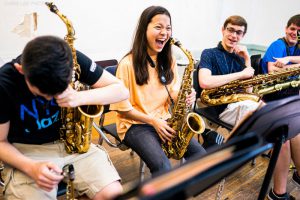
By summer 2018, Sophia already had been involved with MYJB and the Dakota Combo. And then she heard about the National Youth Jazz Orchestra, which was just about to launch its first edition. “I heard about it last year and I was too young to apply. My MYJB director from MYJB 2, Phil Holm, sent out emails to every parent saying everyone should audition for this, it’s like a new cool youth orchestra people should start paying attention to. It’s run by [trumpeter] Sean Jones and it’s a really insane program… I was too young to apply and I forgot about it. And then Eli (Zukor-Zimmerman, a cohort in the Dakota Combo) told me about it. He said “You should audition for this. I remember hearing about it last year and it’s probably going to be really cool.” So, I auditioned for it. I submitted the audition [application]. I remember not liking the audition tapes that I’d made at all because I just hated the sound of it. I thought, there’s no way I’m going to submit this.”
Sophia had taped her audition at Jazz Central Studios. “There’s a studio recording system in there and I couldn’t get it to work. My computer wouldn’t read the SD card and I was thinking, this isn’t going to work. So I used my iPhone, like crap – not crap quality but I could’ve done so much better with the quality of the video.” Apparently the NYO-Jazz thought Sophia’s audition (she played with a quartet), even as taped by her iPhone, was more than adequate. Along with maybe 200 other applicants, she submitted the tape, as well as “a video essay where you had to answer a couple questions with a video camera in your face, like my phone camera in my face. I think it was to try to figure out your personality, see what you’re like. Sean [Jones] was talking about how he chose who would be in the band based on those [videos] as well, to figure out what personalities would combine together…One kid did a studio audition tape because he had to make tapes for college auditions, so he submitted his college stuff, so his was insanely nice, nice quality.”
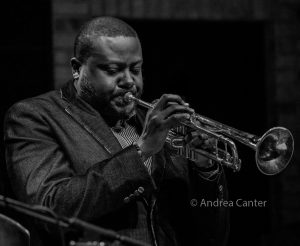
The 2019 NYO-Jazz included 23 musicians (including two altos) and a student sound engineer. In addition to Sean Jones, there were other instructors who worked with the students at their rehearsal center at the State University of New York–Purchase. “At Purchase in New York, when we were rehearsing, there was one instructor for each instrument, and there were two guitar faculty and two drum faculty that switched off. One group was one week and one was the other.” Erica Von Kleist worked with the saxophones. “She’s so killin’. She played flute on one of Chris Potter’s albums [2007’s Song for Anyone]. [The sax section included] five people – two tenors, two altos and a bari…The other alto player played a couple soprano songs.”
The NJO-Jazz experience started in New York, which was the second New York visit for Sophia. “I went when I was really little. I don’t remember anything… We first went to Purchase. It was a campus in New York, an hour away from the city. We went there and rehearsed for two weeks… We rehearsed like eight hours a day. It’d be three hours in the morning and a 2-hour sectional and then a 2-hour rehearsal after that, and we’d do jams or group things where we had a joint thing where we combined with all the other NYOs. So there’s three NYO groups. There’s the jazz NYO, and the USA I think they call it – it’s just like one big classical orchestra. And then there’s NYO 2, which is a younger classical orchestra… There were so many people there, and there’s also another camp going on at the same time that wasn’t music. It was some summer camp, I guess. There were a lot of people. It was really cool, though.”
And it was a lot of hard work! Sophia found that the biggest challenge in Purchase was just “staying awake…We would rehearse from 10 in the morning until 10 at night, and were constantly busy until 10 at night, and then we’d hang out and watch Netflix as a big group in one of the lounge rooms on campus. So we were up until midnight, and then you had to get up early.” But despite the challenge of staying awake, Sophia notes that she “found out why I want to do music. Instead of playing for myself, I’d rather play to inspire other people. I just want someone to hear me and be inspired or motivated by hearing me play, rather than playing for my own benefit. I also learned that I should just be playing what I hear rather than what I think other people should be expecting of me or what other people would want to hear from a youth musician… Sean would always say, ‘Don’t play too hip.’ Like don’t play so hip that it doesn’t even sound modern anymore, like it just sounds like you’re not following the changes after you play something too hip. Don’t play to impress people.”
The repertoire was a significant part of the learning experience and “consisted of numerous styles. We rehearsed and performed about 15 songs so we could have enough songs for 3, hour-long sets. I had never played any of the charts before, but there were many ‘classics’, including ‘A Night in Tunisia,’ ‘Counter Blocking’ (Thad Jones) and ‘Sophisticated Lady.’ In addition, we also played some modern tunes including Freddie Hubbard’s original entitled ‘One of a Kind.’ We played some gospel tunes and burners as well…’
And finally, on July 27, the NYO-Jazz played Carnegie Hall! “It was magical. We spent the whole day there. We left at like 10 in the morning to get to Carnegie. We packed all our stuff up and loaded the bus. We got there at probably 11:30 or 12:00 and then we just ate food first and then we rehearsed for a while, and they gave us free time to walk around and get lunch with our families and stuff… And then after that we got a lot of time to just chill.” The concert itself ended 45 minutes late. “We went way over. Our set went on too long. So then they shooed us out and we had to rush to the bus and get to the airport so we made our flight [to Taiwan]. This was my first time going to Asia.”
Touring Asia
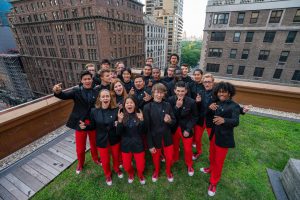
NYO-Jazz toured five cities, including 2 venues in Taiwan, as well as in Hong Kong, Beijing, and Shanghai. “It was four orchestra halls I think, and then their conference building, and then a jazz club. We played at Jazz at Lincoln Center in Shanghai… They were pretty big audiences. It was really awesome. We had an open rehearsal before our Jazz at Lincoln Center set, where there was a ton of kids and parents that came in and watched us rehearse for an hour and a half, and then after, we played a set. But I don’t think most of them stayed. They stayed for rehearsal and then had to go… There was like a cultural exchange thing. I ended up splitting off into a different group. They took five people to a different thing, like a ton of college kids came together in Taipei, which is in Taiwan, and then we played a couple songs for them and just talked for a while, and then the other group – the classical people – played a set and then they [Taiwan students] would play a set.”
“We really had to adapt to each concert hall. I remember the first concert – we didn’t really adapt on the first set. We were not playing to the room. It was super dry, so there was no reverb at all. I remember the first set –we just were playing like we were dead. We were so exhausted from not having any sleep. I remember the second set. We ended up playing it together and it was really awesome. But each concert hall was so different, and then at Jazz at Lincoln Center in Shanghai, it was such a small place that we had to play super quiet for the whole set… . It was like the Black Dog minus that back area, or if you had just the bar area and shrank that, [seated] like 40. [We played super quiet] because the trumpets, if they played solos, it’s so small that it was really loud. I remember we played normal volume.”
As for the audience reaction, “it was varying. Some audiences were really polite. I think they were used to the classical setting where you’re super quiet and you don’t talk and don’t clap or anything. They were classically oriented. But at the Jazz at Lincoln Center club, it was just super, like you could feel the energy from the audience. That was amazing.”
And other highlights of the Asia tour? “Trying the new food. The food was so good. It was so inexpensive. I remember walking down the streets of Taiwan with a group of people and we would go just buy random food off the side of the street just for fun. We were told not to because our stomachs aren’t supposed to be able to handle these foreign foods, but–why not? And it was so cheap. It was like one American dollar for a huge bowl of soup or one plate of fried rice for the whole table. It was crazy. It was really fun to try the new foods and stuff and experience the culture. Learning Asian culture was really fun. My mom’s from Asia [Korea] so I got to experience [some of Asian culture.] There were lots of markets too, where you could walk around and bargain with people. Those were really fun.”
Back in Minnesota
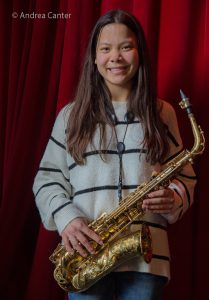
Back in Minnesota, Sophia reflected on the experience. “I think the highlights for me were meeting all the new people that had the same passion as I did. It felt really welcoming and it was super – the people there were so nice. It was like a family there. It’s so awesome. And also traveling and experiencing all the new cultures that I had never experienced before… I met so many people through it that, first of all, I’ll hopefully keep seeing these people that I played with in the future and keep gigging with them, and also see them in college, playing gigs with them. The connections will definitely help me in the future because it’s insane how many connections I ended up with!”
And musically, “It was really inspiring. I’ve never been more motivated to practice and get stuff done music-wise… Just like a lot of gigs. Maybe record some stuff. That would be awesome to start recording some stuff.”
School is back in session, and Sophia already has some gigs coming up. She’ll play with another teen jazz whiz, pianist Owen Finch, on the monthly Youth Jazz Showcase at the Black Dog on September 14. Then the next day, she will bring her own quartet to Crooner’s Lounge in Fridley for the women’s jazz fest — “As Only Women Can”. And she will lead her quartet in November at the Casket Arts Building during the “Open Casket” studio tour on November 2, as well as appearing with MYJB, Apple Valley High School, and more throughout the school year.
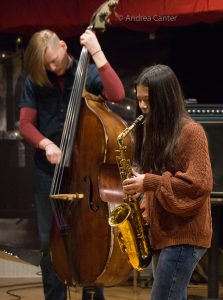
And as a junior, Sophia is looking ahead to college. “I really want to go to New York, but I think I’m just going to go wherever the [scholarship] money leads me. There’s a special program at the University of Miami [Frost School of Music]. It’s every four years. It lines up with my year, so I feel like that’d be really cool…They make a combo and then they tour with that combo and they pay for your room and board and full tuition, completely free. People at NYO were telling me and the other upcoming junior about it.”
Sophia also has a year of private lessons coming up, courtesy of the Irv Williams Scholarship. “I’m extremely honored to receive the first annual Irv Williams Scholarship. The scholarship involved a brief performance at the Dakota Jazz Club [at Irv’s 100th birthday celebration in August], a framed certificate, and a year of free lessons.” As the scholarship’s first recipient, Sophia received $500 for private lessons.
With so many experiences already behind her, it’s hard to imagine what lies ahead for Sophia. But one question she can answer with certainty– will she apply to NYO-Jazz again for next summer? “For sure, 100%. It’s so awesome. It’s such an amazing experience.”
More information about NYO-Jazz is available at https://www.carnegiehall.org/Education/Young-Musicians/National-Youth-Ensembles/NYO-Jazz
